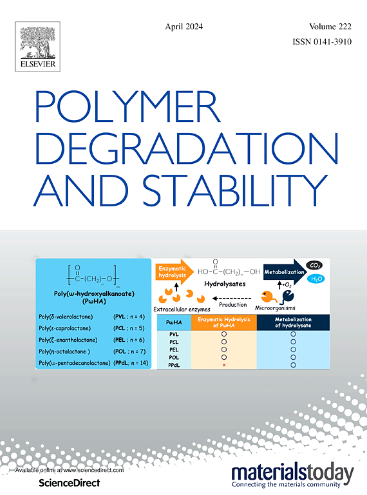通过双重固化机制制备具有超高玻璃化转变温度的丁香酚基阻燃环氧树脂
IF 6.3
2区 化学
Q1 POLYMER SCIENCE
引用次数: 0
摘要
丁香酚环氧树脂作为最具发展前景的生物基环氧树脂之一,仍然面临着耐热性不足、易燃性高、合成工艺复杂等问题。根据狄尔斯-阿尔德(D-A)加成反应和环氧胺开环交联原理,合成了 EUEP 环氧单体(EUEP),并与双马来酰亚胺(BDM)和高温固化剂 4,4′-二氨基二苯砜(DDS)进行了三元共固化(EUEP-BDM-DDS)。由此产生的系统显示出 306 °C 的超高玻璃化转变温度 (Tg),超过了其他丁香酚环氧树脂和商用双酚 A 环氧树脂。EUEP-BDM-DDS 具有优异的机械性能和高模量(拉伸模量高达 4.14 GPa,弯曲模量高达 4.10 GPa)。它的加工特性也很好,具有长固化时间、低粘度的特点,适用于传统 DGEBA-DDS 系统的所有操作流程。此外,固化过程中形成的刚性六元环和较高的交联密度使该树脂体系具有优异的阻燃性能,极限氧指数为 33.5%,通过了 UL-94 的 V-0 级测试。与 DGEBA-DDS 相比,该体系的峰值热释放率和烟雾释放率明显降低,这表明其防火安全性得到了提高。分析结果表明,该系统具有凝聚阻燃机制。此外,由 EUEP-BDM-DDS 制成的复合材料在层间剪切强度、抗弯强度和高温机械性能方面均有改善,优于 DGEBA-DDS 系统。这项研究为在先进复合材料中使用生物基丁香酚环氧树脂铺平了道路,从而提高了复合材料的性能和防火安全性。它对促进生物基材料在高性能复合材料中的应用具有重要意义。本文章由计算机程序翻译,如有差异,请以英文原文为准。
Preparation of eugenol-based flame retardant epoxy resin with an ultrahigh glass transition temperature via a dual-curing mechanism
Eugenol epoxy resin, as one of the most promising biobased epoxy resins, still faces problems of insufficient heat resistance, high flammability, and complicated synthesis processes. Based on the principles of the Diels–Alder (D-A) addition reaction and epoxy-amine open-loop crosslinking, the EUEP epoxy monomer (EUEP) was synthesized, and ternary cocuring (EUEP-BDM-DDS) was performed with bismaleimide (BDM) and the high-temperature curing agent 4,4′-diamino-diphenyl sulfone (DDS). The resulting system exhibited an exceptional glass transition temperature (Tg) of 306 °C, surpassing other eugenol epoxies and commercial bisphenol A epoxies. EUEP-BDM-DDS demonstrated superior mechanical properties with high moduli (up to 4.14 GPa for tensile and 4.10 GPa for flexural). Its processing characteristics were also favorable, featuring a long pot-life, low viscosity, and suitable for all operating processes of traditional DGEBA-DDS systems. In addition, the formation of rigid six-membered rings during curing and the higher cross-linking density gave the resin system excellent flame retardant properties, with a limit oxygen index of 33.5 % and passing the V-0 class test of UL-94. The system exhibited significantly lower peak heat release and smoke release rates compared to DGEBA-DDS, indicating enhanced fire safety. And the analysis revealed a coacervated flame retardant mechanism. Moreover, the composite material derived from EUEP-BDM-DDS displayed improved interlaminar shear strength, flexural strength, and high-temperature mechanical properties, outperforming the DGEBA-DDS system. This study paves the way for utilizing biobased eugenol epoxy resins in advanced composite materials, offering enhanced performance and fire safety. It holds significant implications for promoting the application of biobased materials in high-performance composites.
求助全文
通过发布文献求助,成功后即可免费获取论文全文。
去求助
来源期刊

Polymer Degradation and Stability
化学-高分子科学
CiteScore
10.10
自引率
10.20%
发文量
325
审稿时长
23 days
期刊介绍:
Polymer Degradation and Stability deals with the degradation reactions and their control which are a major preoccupation of practitioners of the many and diverse aspects of modern polymer technology.
Deteriorative reactions occur during processing, when polymers are subjected to heat, oxygen and mechanical stress, and during the useful life of the materials when oxygen and sunlight are the most important degradative agencies. In more specialised applications, degradation may be induced by high energy radiation, ozone, atmospheric pollutants, mechanical stress, biological action, hydrolysis and many other influences. The mechanisms of these reactions and stabilisation processes must be understood if the technology and application of polymers are to continue to advance. The reporting of investigations of this kind is therefore a major function of this journal.
However there are also new developments in polymer technology in which degradation processes find positive applications. For example, photodegradable plastics are now available, the recycling of polymeric products will become increasingly important, degradation and combustion studies are involved in the definition of the fire hazards which are associated with polymeric materials and the microelectronics industry is vitally dependent upon polymer degradation in the manufacture of its circuitry. Polymer properties may also be improved by processes like curing and grafting, the chemistry of which can be closely related to that which causes physical deterioration in other circumstances.
 求助内容:
求助内容: 应助结果提醒方式:
应助结果提醒方式:


